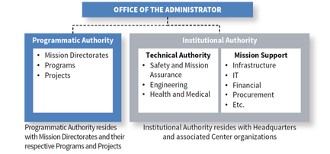
Procedural
Requirements
Effective Date: September 08, 2020
Expiration Date: September 08, 2025

|
NASA Procedural Requirements |
NPR 7120.11A Effective Date: September 08, 2020 Expiration Date: September 08, 2025 |
| | TOC | Preface | Chapter1 | Chapter2 | Chapter3 | Chapter4 | Chapter5 | AppendixA | AppendixB | AppendixC | ALL | |
As defined in NPD 1000.0, NASA Governance and Strategic Management Handbook, the NASA management system incorporates a robust system of checks and balances between the Programmatic and Institutional Authorities as an important element supporting the achievement of mission success. Figure 1 illustrates the NASA Authority Structure tracing back to the Office of the Administrator. The HMTA provides key support individuals at appropriate program and project organizational levels who have a formally delegated Technical Authority (TA) role traceable to the Administrator, and who are funded independent of the Programmatic Authority. These individuals promote open communication, serve to disposition requests for relief to established institutional requirements, provide independent oversight of programs and projects, and will collaborate with the Engineering and Safety and Mission Assurance TAs, as needed, in support of safety and mission success.
The CHMO, as described in NPD 1000.3, The NASA Organization, serves as the Agency HMTA. As the office of primary responsibility, the Office of the Chief Health and Medical Officer implements the HMTA function to ensure health, medical, and human performance policy, requirements, and standards are addressed in program and project activities to protect the health and lives of astronauts, aviation flight crews, and other occupants of flight vehicles, from hazards associated with performing the flight missions and associated testing and training (see Figure 1).

Figure 1. NASA Authority Structure
The mission of the HMTA is to both: a) prevent and mitigate adverse health and medical events and b) provide for the human performance required for successful mission execution. The HMTA is applied from program inception through operations. Specifically, the HMTA:
a. Develops and maintains NASA health, medical, and human performance policy, standards, and requirements for NASA programs and projects.
b. Dispositions requests for relief from NASA occupational, health, medical, and human performance policy, requirements, and standards. NASA-unique occupational health requirements under the scope of the HMTA are described in NPR 1800.1, NASA Occupational Health Program Procedures.
c. Develops a disciplined systematic approach to identifying, analyzing, and controlling health, medical, and human performance risks that affect the human involved in flight.
| TOC | Preface | Chapter1 | Chapter2 | Chapter3 | Chapter4 | Chapter5 | AppendixA | AppendixB | AppendixC | ALL | |
| | NODIS Library | Program Formulation(7000s) | Search | |
This document does not bind the public, except as authorized by law or as incorporated into a contract. This document is uncontrolled when printed. Check the NASA Online Directives Information System (NODIS) Library to verify that this is the correct version before use: https://nodis3.gsfc.nasa.gov.